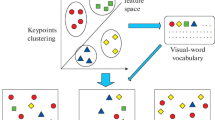Abstract
One of the major problems in power distribution networks is abnormal heating associated with high resistance or excessive current flow, in which some of the affected components include three-phase transformers, switches, connectors, fuses, etc. Utility Pole detection aids in the classification of these affected components; thus, the importance of its study. In this work, we propose a method to detect the utility poles using a database of images obtained from Google Maps for the region of Campinas/SP. The Bag of Visual Words (BoVW) method was used to classify the two classes (those that are utility poles and those that are not utility poles), and know if the sub-image obtained belongs to a utility pole class.
Access this chapter
Tax calculation will be finalised at checkout
Purchases are for personal use only
Similar content being viewed by others
References
Suarez, O.D., del Carrobles, M.M.F., Enano, N.V., García, G.B., Gracia, I.S., Incertis, J.A.P., Tercero, J.S.: OpenCV Essentials. Packt Publishing Ltd., Birmingham (2014)
Kaspers, A.: Blob detection (2011)
Lowe, D.: Local feature view clustering for 3D object recognition. In: Proceedings of the 2001 IEEE Computer Society Conference on Computer Vision and Pattern Recognition, CVPR 2001, vol. 1. IEEE Computer Society, pp. I-682–I-688 (2001)
Rublee, E., Rabaud, V., et al.: ORB: an efficient alternative to SIFT or SURF. In: 2011 International Conference on Computer Vision, pp. 2564–2571. IEEE, November 2011
Rosten, E., Drummond, T.: Machine learning for high-speed corner detection. In: Leonardis, A., Bischof, H., Pinz, A. (eds.) ECCV 2006. LNCS, vol. 3951, pp. 430–443. Springer, Heidelberg (2006). doi:10.1007/11744023_34
Lowe, D.: Object recognition from local scale-invariant features. In: Proceedings of the Seventh IEEE International Conference on Computer Vision, vol. 2, pp. 1150–1157. IEEE (1999)
Bay, H., Ess, A.: Speeded-up robust features (SURF). Comput. Vis. Image Underst. J. 110, 346–359 (2008). Elsevier
Leutenegger, S., Chli, M., Siegwart, R.Y.: BRISK: binary robust invariant scalable keypoints. In: Proceedings of the IEEE International Conference on Computer Vision, pp. 2548–2555 (2011)
Yang, J., Jiang, Y.-G.: Evaluating bag-of-visual-words representations in scene classification. In: Proceedings of the International Workshop on Workshop on Multimedia Information Retrieval, pp. 197–206 (2007)
Lazebnik, S., Schmid, C., Ponce, J.: Beyond bags of features: spatial pyramid matching for recognizing natural scene categories. In: Proceedings of the IEEE Computer Society Conference on Computer Vision and Pattern Recognition, vol. 2, pp. 2169–2178 (2006)
Boswell, D.: Introduction to support vector machines. http://dustwell.com/PastWork/IntroToSVM.pdf
Subhransu, M., Alexander, C., Jitendra, M.: Classification using intersection kernel support vector machines is efficient. In: IEEE Computer Vision and Pattern Recognition (2008)
Acknowledgments
The authors acknowledge the financial support from “Companhia Paulista de Força e Luz -“CPFL”, “Companhia Piratininga de Força e Luz”, “Rio Grande Energia S/A” and “Companhia Sul Paulista de Energia”. Thanks also to the companies participating in this project: KascoSys P&D and RFerrarezi, both based in the city of Campinas–Brazil.
Author information
Authors and Affiliations
Corresponding author
Editor information
Editors and Affiliations
Rights and permissions
Copyright information
© 2017 Springer International Publishing AG
About this paper
Cite this paper
Cabello, F.C., Iano, Y., Arthur, R., Dueñas, A., León, J., Caetano, D.G. (2017). Automatic Detection of Utility Poles Using the Bag of Visual Words Method for Different Feature Extractors. In: Felsberg, M., Heyden, A., Krüger, N. (eds) Computer Analysis of Images and Patterns. CAIP 2017. Lecture Notes in Computer Science(), vol 10425. Springer, Cham. https://doi.org/10.1007/978-3-319-64698-5_11
Download citation
DOI: https://doi.org/10.1007/978-3-319-64698-5_11
Published:
Publisher Name: Springer, Cham
Print ISBN: 978-3-319-64697-8
Online ISBN: 978-3-319-64698-5
eBook Packages: Computer ScienceComputer Science (R0)




